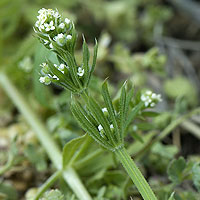Cleavers
Uses
Parts Used & Where Grown
Cleavers grow in wet areas of Britain, Europe, Asia, and North America. Small prickles grow on the leaves of cleavers, causing it to have a sticky feeling and giving it its name. The leaves and flowers of cleavers are used medicinally.
Our proprietary “Star-Rating” system was developed to help you easily understand the amount of scientific support behind each supplement in relation to a specific health condition. While there is no way to predict whether a vitamin, mineral, or herb will successfully treat or prevent associated health conditions, our unique ratings tell you how well these supplements are understood by the medical community, and whether studies have found them to be effective for other people.
For over a decade, our team has combed through thousands of research articles published in reputable journals. To help you make educated decisions, and to better understand controversial or confusing supplements, our medical experts have digested the science into these three easy-to-follow ratings. We hope this provides you with a helpful resource to make informed decisions towards your health and well-being.
3 StarsReliable and relatively consistent scientific data showing a substantial health benefit.
2 StarsContradictory, insufficient, or preliminary studies suggesting a health benefit or minimal health benefit.
1 StarFor an herb, supported by traditional use but minimal or no scientific evidence. For a supplement, little scientific support.
This supplement has been used in connection with the following health conditions:
| Used for | Why |
|---|---|
1 Star Edema Refer to label instructions | Cleavers is one of numerous plants considered in ancient times to act as a diuretic. It was therefore used to relieve edema and to promote urine formation during bladder infections. is one of numerous plants considered in ancient times to act as a diuretic. It was therefore used to relieve edema and to promote urine formation during bladder infections. |
Traditional Use (May Not Be Supported by Scientific Studies)
Cleavers is one of numerous plants considered in ancient times to act as a diuretic.1 It was therefore used to relieve edema and to promote urine formation during bladder infections. It has also been used by people with lymph swellings, jaundice, and wounds.
How It Works
Galiosin, an anthraquinone glycoside, other glycosides, tannins, and flavonoids may be the major constituents of cleavers. Little research has been conducted on this plant, but preliminary lab experiments suggest it may have antispasmodic activity.2
How to Use It
Cleavers tincture and tea are most widely recommended by herbal practitioners. Tincture (1/2–1 teaspoon or 3–5 ml) can be taken three times per day. Tea is made by steeping 2–3 teaspoons (10–15 grams) of the herb in 1 cup (250 ml) of hot water for ten to fifteen minutes. People can drink three or more cups per day.
Interactions with Supplements, Foods, & Other Compounds
Interactions with Medicines
Certain medicines interact with this supplement.
Replenish Depleted Nutrients
none
Reduce Side Effects
none
Support Medicine
none
Reduces Effectiveness
none
Potential Negative Interaction
Explanation Required
none
Side Effects
1. Mills SY. Out of the Earth: The Essential Book of Herbal Medicine. London: Viking Arkana, 1991, 493-4.
2. Mills SY. Out of the Earth: The Essential Book of Herbal Medicine. London: Viking Arkana, 1991, 493-4.
Last Review: 05-23-2015

Copyright © 2024 TraceGains, Inc. All rights reserved.
Learn more about TraceGains, the company.
The information presented by TraceGains is for informational purposes only. It is based on scientific studies (human, animal, or in vitro), clinical experience, or traditional usage as cited in each article. The results reported may not necessarily occur in all individuals. For many of the conditions discussed, treatment with prescription or over the counter medication is also available. Consult your doctor, practitioner, and/or pharmacist for any health problem and before using any supplements or before making any changes in prescribed medications. Information expires December 2024.
This information does not replace the advice of a doctor. Ignite Healthwise, LLC, disclaims any warranty or liability for your use of this information. Your use of this information means that you agree to the Terms of Use. Learn how we develop our content.

